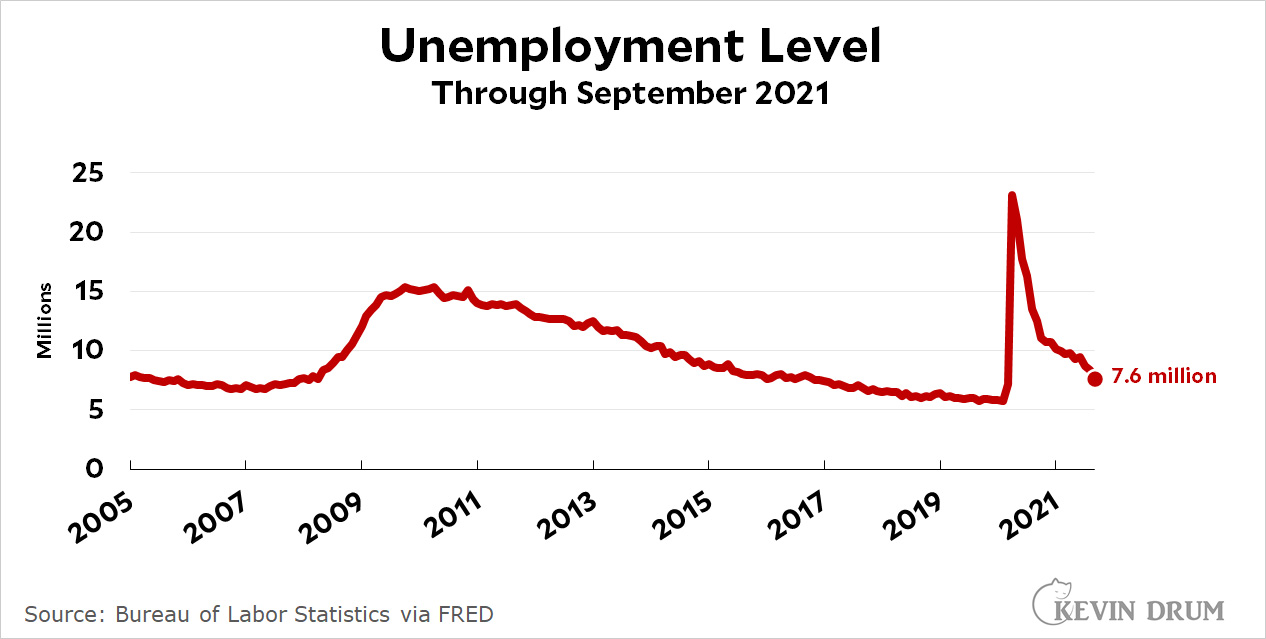This chart shows the unemployment level over the past couple of decades. Not the rate, the level:
 The baseline during good economic times is about 6 million people. This represents the normal churn of people leaving jobs for a few weeks before starting up new ones. The unemployment level never gets much below this, and we're pretty close to it now.
The baseline during good economic times is about 6 million people. This represents the normal churn of people leaving jobs for a few weeks before starting up new ones. The unemployment level never gets much below this, and we're pretty close to it now.
Normally, it takes a long time to recover from a recession. As you can see in the chart, the unemployment level spiked up to 15 million in 2009 and it took until 2017 to get back to a level of 7.6 million. In the case of the pandemic, however, the spike was bigger but it's taken only 18 months to get back to 7.6 million.
This means there are about 1.7 million people left who want a job but don't have one. If employers really want more workers—and they claim to have 10 million job openings¹—they're going to have to do something to bring more people off the sidelines and into the workforce. That "something" is higher wages. There aren't very many other alternatives.
¹But see here for more context about what this really means.

On the job training would also be nice.
Technically, though, this shouldn't be needed. If you want to return to pre-2020 those one point something million workers were already doing their jobs then. How much could have changed? Probably not that much.
Worker training would be great but I'm not sure it is absolutely necessary. What we are seeing is the market adjusting to new demand patterns as it returns to normal IMO.
A lot of jobs require training or experience that a decent chunk of people can't afford to do. A lot of skilled jobs also work best with training+apprenticeship. Remember there was a lot of retirements and deaths among the olds. So these are not the same people and a lot more people want a job that is not the shit they had before. I think the low hanging fruit has been picked.
Then there's people like me who are stuck in child care until under 4s can be vaccinated.
10 years ago people were predicting that we would have a worker shortage now because of demographic trends.
And lookie! They were correct. Demographic trends are usually pretty easy to forecast.
Our local paper was running one of those "nobody can find workers" stories this morning, mostly consisting of local small business owners carping about how everyone now is lazy and soft and doesn't want to work anymore. Nary a word about whether they had tried to draw workers back with better pay or benefits. At the very end, however, it featured the owner of a local chain of grocery stores that recently raised it's base hourly pay by $2/hr and -- shockingly! -- has all the employees they need. It was left as an exercise for the reader to deduce the lesson here.
There was a shortage before the pandemic.
At 7.6 million. So, depending on how you want to slice it, we are either still 27% higher than baseline, or we have another 21% reduction to go to get to baseline. That, presumably, is the definition of pretty close to use henceforth.
Yes there are alternatives to getting more workers other than raising wages. One of them is that workers run out of the money that they saved from the stimulus payments, or that they finally start feeling the pinch for rent and mortgage. Not all rent moratoria have run out and there are still billions in rent support that remain to be paid out. Many workers may not desperately need the money and are staying out because of covid.
The number of jobs that the economy "needs" is probably given by the Census's employment surveys, one for employers and another for "households" or employees:
https://fred.stlouisfed.org/graph/?g=HCqc
The Feb 2020 level also gives the number of workers who are potentially available, and as Kevin has shown before, there are many millions still out by this reckoning. The unemployment numbers that Kevin gives in this post are from different sources, as is the formal unemployment rate. That unemployment rate is probably not representative of the number of workers who would make themselves available in some months time under non-pandemic conditions.
Many reporters, pundits and bloggers have gotten the idea into their little heads that the pandemic has permanently changed the attitude of workers or that they somehow acquired powers that they didn't have before, so that they will demand higher wages and better conditions. I suspect that this is a result of the "irrational exuberance" that obviously affects the stock market and other speculative markets, and maybe also the relief at getting Trump out. Workers are demanding more now, but it remains to be seen how long they can keep it up. Long-term change will probably require legislation, which will be hard to come by unless Democrat miraculously get supermajorities in 2022.
Sorry the employment surveys are BLS, not Census.
Pingback: The worker shortage in one chart | Later On
I am all for better wages But would ramping up immigration and skilled worker visas help with worker shortages, too?